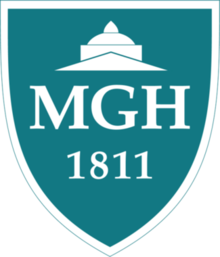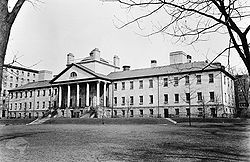- Massachusetts General Hospital
-
Massachusetts General Hospital Partners HealthCare 

Main entrance of Massachusetts General Hospital Geography Location 55 Fruit Street, Boston, Massachusetts, United States Coordinates 42°21′46.10″N 71°04′07.07″W / 42.362806°N 71.0686306°WCoordinates: 42°21′46.10″N 71°04′07.07″W / 42.362806°N 71.0686306°W Organization Hospital type Teaching Affiliated university Harvard Medical School Services Emergency department Level I Trauma Center and Level I Pediatric Trauma Center[1] Helipad (FAA LID: 0MA1) Beds 1,057[2] History Founded 1811[3] Links Website massgeneral.org Lists Hospitals in Massachusetts Massachusetts General Hospital (Mass General or MGH) is a teaching hospital and biomedical research facility in the West End neighborhood of Boston, Massachusetts. With the opening of the Lunder Building in 2011, it is the largest hospital in New England with 1,057 beds.[2]
It has most recently been ranked as the second best hospital in the United States, behind Johns Hopkins Hospital, by U.S. News & World Report.[4][5]
MGH was the original teaching affiliate of Harvard Medical School and is currently one of over a dozen hospitals affiliated with HMS. MGH is owned by Partners HealthCare, which it founded with Brigham and Women's Hospital in 1994. MGH is also a member of the consortium which operates Boston MedFlight.
MGH is affiliated with the Dana-Farber Cancer Institute through Dana-Farber/Partners Cancer Care and the Dana-Farber/Harvard Cancer Center.[6]
Contents
History
Founded in 1811,[3] the original hospital was designed by the famous American architect Charles Bulfinch.[7] It is the third-oldest general hospital in the United States.[3] John Warren, Professor of Anatomy and Surgery at Harvard Medical School, spearheaded the move of the medical school to Boston. Warren's son, John Collins Warren, along with James Jackson, led the efforts to start the Massachusetts General Hospital. Because all those who had sufficient money were cared for at home, Massachusetts General Hospital, like most hospitals that were founded in the 19th century, was intended to care for the poor.[8] During the mid-to-late 19th century, Harvard Medical School was located adjacent to Massachusetts General Hospital.
The first American hospital social workers were based in the hospital.[9]
The hospital's work with developing specialized computer software systems for medical use in the 1960s led to the development of the MUMPS programming language, which stands for "Massachusetts General Hospital Utility Multi-Programming System," an important programming language and data-base system heavily used in medical applications such as patient records and billing. A major patient database system called File Manager, which was developed by the Veterans Administration (now the Department of Veterans' Affairs), was created using this language.
Early use of anesthesia
It was in the Ether Dome of MGH in October 1846,[7] that a local dentist, William Thomas Green Morton, was invited to perform a public demonstration of the administration of inhaled ether to produce insensibility to pain during surgery.[7] Several years prior, Dr. Crawford Long of Danielsville, Georgia had given ether for surgery, but his work was unknown outside Georgia until he published his experience in 1849. On 16 October 1846, after administration of ether by Morton, MGH Chief of Surgery, John Collins Warren, painlessly removed a tumor from the neck of a local printer, Edward Gilbert Abbott.[7] Upon completion of the procedure, which was without screaming or restraint, the usually skeptical Warren reportedly quipped, "Gentlemen, this is no humbug." News of this "anesthesia" invention rapidly traveled within months around the world.[10]
A reenactment of the Ether Dome event was painted in 2000 by artists Warren and Lucia Prosperi. They used the then-MGH staff to pose as their counterparts from 1846.[11] The Ether Dome still exists[7] and is open to the public.
An anesthesia department was established at the MGH in 1936 under the leadership of Henry Knowles Beecher.
Facilities and current operations
 The Bulfinch Building as it appeared in 1941, including the Ether Dome.
The Bulfinch Building as it appeared in 1941, including the Ether Dome.
The main MGH campus is located at 55 Fruit Street in Boston, Massachusetts. It has expanded into an area formerly known as the West End, adjacent to the Charles River and Beacon Hill. The hospital handles over one million outpatients each year at its main campus, as well as its seven satellite facilities in Boston at Back Bay, Charlestown, Chelsea, Everett, Revere, Waltham and Danvers. With more than 20,000 employees, the hospital is the largest non-governmental employer in Boston.[citation needed]
The hospital has 907 beds and admits over 45,000 patients each year.[citation needed] The surgical staff performs over 34,000 operations yearly.[citation needed] The obstetrics service handles over 3,500 births each year.[citation needed] The Massachusetts General Hospital Trauma Center is the oldest and largest American College of Surgeons-verified Level One Trauma Center in New England,[citation needed] evaluating and treating over 2600 trauma patients per year.[citation needed] Architect Hisham N. Ashkouri, working in conjunction with Hoskins Scott Taylor and Partners, provided the space designs and schematics for the pediatrics, neonatal intensive care, and in-patient related floors, as well as the third floor surgical suites and support facilities. In the fall of 2004, the Yawkey Center for Outpatient Care (named for Jean R. Yawkey) opened. This 440,000-square-foot (41,000 m2) ten-floor facility is the largest and most comprehensive outpatient building in New England.[citation needed]
Since 1994, MGH has been awarded the most research funding for an independent hospital by the National Institutes of Health,[12] receiving over $285 million dollars alone in 2004.[13] MGH is also home to the world-renowned Mallinckrodt General Clinical Research Center.
The closest MBTA stop to the main campus is Charles/MGH on the Red Line. On March 27, 2007, the new Charles/MGH station was opened with new renovations, including handicap accessible elevators.[14] There are five main food service areas for the general public on the MGH campus. They include the Eat Street Cafe in the lower level of the Ellison Building, the Blossom Street Cafe in the Cox lobby, Coffee Central in the White lobby, Tea Leaves and Coffee Beans in the Wang Ambulatory Care Center, and Coffee South in the Yawkey outpatient center.
Affiliated institutions
Massachusetts General Hospital is affiliated with Harvard Medical School and is its original teaching hospital. Together they form an academic health science center. MGH reports it conducts the largest hospital-based research program in the United States, with an annual research budget of over $500 million.[15] Research centers cover many areas including AIDS, cardiovascular research, cancer, human genetics, medical imaging, neurodegenerative disorders, regenerative medicine, transplantation biology and photomedicine.[16] In February 2009, the Phillip T. and Susan M. Ragon Institute of immunology was founded to bolster research into creating vaccines and other therapies for acquired immune system conditions, chiefly AIDS. It was made possible by a $100 million gift over ten years, and represents the largest single donation made to MGH.[17]
Though it has its own chief of psychiatry and top ranking department, MGH is closely affiliated with nearby McLean Hospital, a psychiatric hospital also affiliated with Harvard Medical School.[citation needed]
Awards and Recognition
Nobel Laureates
There have been ten Nobel Laureates who have either worked or trained at MGH.[18]
- 1934 George R. Minot, MD
- 1947 Carl F. Cori, PhD
- 1953 Fritz A. Lipmann, MD, PhD
- 1972 Gerald M. Edelman, MD, PhD
- 1985 Michael S. Brown, MD, and Joseph L. Goldstein, MD
- 1989 J. Michael Bishop, MD
- 1998 Ferid Murad, MD, PhD
- 2009 Jack W. Szostak, PhD
- 2011 Ralph Steinman, MD
Rankings
In 2011, MGH was named the second best hospital in the United States by U.S. News & World Report. MGH consistently ranks as one of the country's top hospitals in U.S. News & World Report.[citation needed] In 2011, MGH was also ranked as one of the top three hospitals in the country for five specialties, including Diabetes & Endocrinology, Ear, Nose & Throat, Neurology & Neurosurgery, Orthopedics and Psychiatry.
In 2003, MGH was named the state's first Magnet hospital by the American Nurses Credentialing Center, a subsidiary of the American Nurses Association. Magnet recognition represents the highest honor awarded for nursing excellence.[citation needed]
In August 2011, Becker's Hospital Review listed MGH as number 12 on the 100 Top Grossing Hospitals in America with $5.64 billion in gross revenue. [19]
Educational units
- Massachusetts General Hospital Academy
- Massachusetts General Hospital Psychiatry Academy
- MGH Institute of Health Professions
See also
- Proto magazine
- Schwartz Center for Compassionate Healthcare
References
- ^ "Verified Trauma Centers". American College of Surgeons. http://www.facs.org/trauma/verified.html. Retrieved 2011-09-14.
- ^ a b "Massachusetts Licensed Health Care Facility/Agency Listing". Commonwealth of Massachusetts Department of Health and Human Services. http://www.mass.gov/Eeohhs2/docs/dph/quality/healthcare/healthcare_facilities.xls. Retrieved 2011-09-09.
- ^ a b c Liz Kowalczyk (February 26, 2011). "A great institution rises and, with it, the healing arts". The Boston Globe. http://www.boston.com/lifestyle/health/articles/2011/02/26/massachusetts_general_hospital_rises_and_with_it_the_healing_arts/. Retrieved 2011-02-26.
- ^ "Massachusetts General Hospital". U.S.News & World Report. http://health.usnews.com/best-hospitals/massachusetts-general-hospital-6140430. Retrieved 2011-02-26.
- ^ Avery Comarow (July 14, 2010). "Best Hospitals 2010-11: The Honor Roll". U.S.News & World Report. http://health.usnews.com/health-news/best-hospitals/articles/2010/07/14/best-hospitals-2010-11-the-honor-roll. Retrieved 2011-02-26.
- ^ Dana-Farber Cancer Institute. "Partners and Affiliates". http://www.dana-farber.org/About-Us/Partners-and-Affiliates.aspx. Retrieved 2011-09-09.
- ^ a b c d e Sara Brown (February 23, 2011). "New Beacon Hill museum will showcase MGH medical innovations". The Boston Globe. http://www.boston.com/yourtown/news/beacon_hill/2011/02/new_beacon_hill_museum_will_sh.html. Retrieved February 26, 2011.
- ^ Harvard Medical School: A History and Background
- ^ Beder, J. (2006). Hospital Social Work: The interface of medicine and caring... Routlege: New York
- ^ Fenster, J. M. (2001). Ether Day: The Strange Tale of America's Greatest Medical Discovery and the Haunted Men Who Made It. New York, NY: HarperCollins. ISBN 978-0060195236.
- ^ Museum at Mass General
- ^ NIH Research Portfolio Online Reporting Tools (RePORT)
- ^ NIH Awards to Independent Domestic Hospitals - Fiscal Year 2004
- ^ New Charles/MGH Station Opens
- ^ Hospital Overview - Massachusetts General Hospital, Boston, MA
- ^ Intensive summer program helps physicians build clinical research careers - Massachusetts General Hospital, Boston, MA
- ^ The Ragon Institute of MGH, MIT and Harvard
- ^ {{Massachusetts General Hospital. "MGH Nobel Prize Laureates throughout history". http://www.massgeneral.org/about/newsarticle.aspx?id=1911. Retrieved 2011-10-21.
- ^ Becker's Hospital Review
External links
U.S. National Register of Historic Places Topics Lists by states Alabama • Alaska • Arizona • Arkansas • California • Colorado • Connecticut • Delaware • Florida • Georgia • Hawaii • Idaho • Illinois • Indiana • Iowa • Kansas • Kentucky • Louisiana • Maine • Maryland • Massachusetts • Michigan • Minnesota • Mississippi • Missouri • Montana • Nebraska • Nevada • New Hampshire • New Jersey • New Mexico • New York • North Carolina • North Dakota • Ohio • Oklahoma • Oregon • Pennsylvania • Rhode Island • South Carolina • South Dakota • Tennessee • Texas • Utah • Vermont • Virginia • Washington • West Virginia • Wisconsin • WyomingLists by territories Lists by associated states Other Categories:- Academic health science centres
- Buildings and structures on the National Register of Historic Places in Massachusetts
- Harvard Medical School
- Hospitals established in the 1810s
- Hospitals in Boston, Massachusetts
- Massachusetts General Hospital
- National Historic Landmarks in Massachusetts
- University hospitals in the United States
- West End, Boston
Wikimedia Foundation. 2010.

